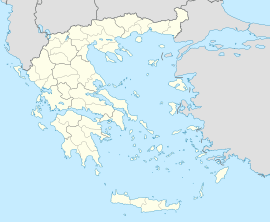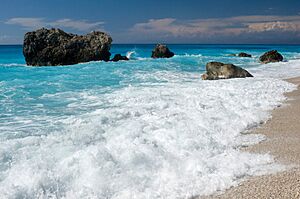Lefkada facts for kids
Quick facts for kids
Lefkada
Λευκάδα
|
|
|---|---|

View of Lefkada (city)
|
|
| Country | Greece |
| Administrative region | Ionian Islands |
| Regional unit | Lefkada |
| Area | |
| • Municipality | 333.6 km2 (128.8 sq mi) |
| Population
(2021)
|
|
| • Municipality | 21,900 |
| • Municipality density | 65.65/km2 (170.0/sq mi) |
| Time zone | UTC+2 (EET) |
| • Summer (DST) | UTC+3 (EEST) |
Lefkada (Greek: Λευκάδα, Lefkáda), also called Lefkas or Leukas, is a beautiful Greek island. It is located in the Ionian Sea on the west coast of Greece. The island is connected to the mainland by a long causeway and a floating bridge. This makes it easy to visit!
The main town on the island is also called Lefkada. It is in the northern part of the island. You can reach it from Aktion National Airport in about 25 minutes by car. Lefkada island is part of the regional unit of Lefkada.
Contents
Exploring Lefkada: Geography and Nature
Lefkada is about 35 kilometers (22 miles) long from north to south. It is about 15 kilometers (9 miles) wide from east to west. The island covers an area of about 302 square kilometers (117 square miles). The highest point is Stavrota mountain, which is 1,158 meters (3,799 feet) above sea level. It sits right in the middle of the island.
Coastal Towns and Beaches
The east coast of Lefkada has many small towns. These include Lygia, Nikiana, and Perigiali. They are all north of Nidri, which is the biggest resort on the island. Nidri has amazing views of Skorpios island (once owned by Aristotle Onassis). You can also see Meganisi and other small islands, plus the Greek mainland.
From Nidri, you can take car ferries to Kefalonia, Ithaca, and Meganissi. About 20 kilometers (12 miles) south of Nidri is Vasiliki. This town is famous for windsurfing. Ferries to Kefalonia and Ithaca also leave from Vasiliki.
Famous Cliffs and Beaches
South of Vasiliki is Cape Lefkada. Ancient stories say that the poet Sappho jumped from these 30-meter (98-foot) high cliffs. The famous Porto Katsiki beach is on Lefkada's west coast. It is known for its stunning blue waters and white cliffs.
Long ago, Lefkada was actually connected to mainland Greece. In the 7th century BC, people from Corinth dug a trench to separate it. This made it an island. The southernmost tip of the island is called Cape Dukato. Sometimes, this name is used for the whole island.
Lefkada's Climate
Lefkada has a typical Mediterranean climate. This means it has hot, sunny summers. The winters are cool and mild. This kind of weather is perfect for enjoying the island's natural beauty.
A Journey Through Time: Lefkada's History
Ancient Legends and Discoveries
Lefkada is linked to many ancient Greek myths. Stories connect the island to Aphrodite, the goddess of love. The island is also part of the tales of Odysseus, the hero from Homer's Odyssey. A German archaeologist named Wilhelm Dörpfeld believed Lefkada was Homer's Ithaca. He thought Odysseus's palace was west of Nydri.
Local tourism officials also point to parts of the Odyssey that suggest Lefkada was Ithaca. For example, the Odyssey describes Ithaca as an island you could reach on foot. Lefkada was connected to the mainland by a narrow causeway, so you could walk to it. Ancient writers called Leucas a colony of Corinth.
Medieval Times: Changes in Rule
After the ancient times, not much is known about Lefkada during the early Byzantine period. The island became known as Santa Maura in 1292. In 1295, the island was given to John I Orsini. He built a castle there, which became the Castle of Santa Maura.
Different rulers took control of Lefkada over the centuries. In 1360, Leonardo I Tocco took over. He even called himself the "duke of Lucate." The island was sometimes called "the Duchy" because of this. The Tocci family made the island their main base. They made the fortified town bigger.
In 1479, the Ottomans captured Lefkada. They also took Cephalonia and Zakynthos. Some of the people were moved to Constantinople. This was part of the Ottoman plan to repopulate their capital city.
Ottoman Rule and Venetian Conquest
The Ottomans called the island Levkada. The castle and capital were called Aya Mavra. This name came from the Greek "Agia Mavra," meaning "Santa Maura." Most people lived in the castle and capital. In 1564, a 3-kilometer (1.9-mile) long aqueduct was built. It brought water from the island's center to the town. This was a very important project.
The Ottomans rebuilt and made the castle larger in 1572–1574. It became a strong hexagonal fortress. In the 17th century, Lefkada became its own separate area within the Ottoman Empire.
In 1684, the Venetians conquered the island. They took it after a sixteen-day siege. The Venetians destroyed the walled town and its suburbs. Only one suburb remained, which became the main town of Lefkada. The Venetians also removed all buildings connected to Islam. They modernized the castle in the 1710s.
Venetian rule lasted until 1797. There was a small rebellion by local Greeks in 1769.
Modern History: Union with Greece
After the Venetians, the French took control of Lefkada in 1797. Then, a Russian-Turkish group captured it in 1799. In 1800, the Septinsular Republic was formed. This was a Russian protectorate. In 1807, the French took over again. But in 1810, the British captured the island.
In 1815, the United Kingdom created the United States of the Ionian Islands. This was a protectorate that included Lefkada. A big earthquake in 1825 destroyed much of the town. The Ottoman aqueduct was also damaged. After this, the town was rebuilt using wood. This helped prevent similar damage from future earthquakes.
Finally, in 1864, Lefkada and the other Ionian Islands became part of Greece. At that time, about 24,000 people lived on the island.
Lafcadio Hearn Historical Center
The first museum in Europe for Lafcadio Hearn opened in Lefkada on July 4, 2014. He was born on the island and named after it. The museum has old books, rare items, and Japanese collectibles. Visitors can learn about Lafcadio Hearn's life through photos and texts. They can also explore the cultures of Europe, America, and Japan from the late 1800s and early 1900s. Many people from Japan and Greece helped create this center.
Lefkada's Municipality
The current municipality of Lefkada was created in 2011. It joined together seven smaller areas. These areas are now called municipal units:
- Apollonioi
- Ellomenos
- Kalamos
- Karya
- Kastos
- Lefkada (city)
- Sfakiotes
The municipality includes the main island of Lefkada. It also includes the smaller islands of Kastos and Kalamos.
Education and Transport
Lefkada is home to a Regional Development department. This is part of the Ionian University. For transport, the island uses Greek National Road 42. The nearest airport is Aktion (Preveza) Airport.
Famous People from Lefkada

Many notable people have connections to Lefkada. Here are a few:
- Frederick Temple (1821–1902), who became the Archbishop of Canterbury.
- Aristotelis Valaoritis (1824–1879), a famous poet and politician.
- Lafcadio Hearn (1850–1904), a writer born on the island. He wrote about different cultures.
- Aggelos Sikelianos (1884–1951), a well-known poet and playwright.
- Aristotle Onassis (1906–1975), a very successful Greek shipping businessman.
- Agnes Baltsa (1944-), a famous opera singer.
- Marina Lambrini Diamandis (1985-), a popular singer and songwriter.
Images for kids
-
A traditional street in Lefkada (city).
See also
 In Spanish: Léucade para niños
In Spanish: Léucade para niños















